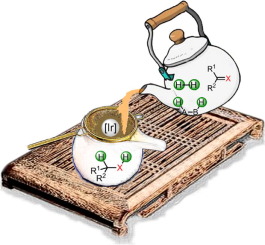Coordination Chemistry Reviews ( IF 20.3 ) Pub Date : 2020-02-28 , DOI: 10.1016/j.ccr.2020.213251 Cheng-Xing Cui , Haohua Chen , Shi-Jun Li , Tao Zhang , Ling-Bo Qu , Yu Lan

|
Ir catalysis is widely used in hydrogenation reactions to transform unsaturated molecules to the corresponding saturated molecules. Understanding the reaction mechanism is helpful for design of new Ir-catalyzed hydrogenation reactions, as well as for controlling the regio/stereoselectivity. Density functional theory is a powerful tool for mechanistic study of organometallic catalysis, and it has been widely used to reveal the reaction pathways in this research area. With the development of computational methods, much progress has recently been made in mechanistic study of Ir-catalyzed hydrogenation reactions. Herein, we present a review of theoretical studies of the mechanism of Ir-catalyzed homogeneous hydrogenation. A redox pathway is commonly proposed for hydrogenation of non-polar unsaturated bonds, which involves oxidative addition of a hydrogen molecule to afford a high valence Ir hydride complex, insertion of an unsaturated bond into the Ir–H bond, and reductive elimination. Alternatively, the dihydrogen molecule can undergo a heterolysis reaction to provide a formal hydride ion and a proton. Subsequent nucleophilic and electrophilic attack can then also achieve hydrogenation of the polar unsaturated bond. In this review, the studies of the mechanism of Ir-catalyzed hydrogenation are classified according to the type of substrate: olefins, carbonyls, and imines. In each category, the reactions are discussed with respect to the various hydrogen sources. The stereochemistry and substituent effect in Ir-catalyzed hydrogenation are also considered.
中文翻译:

Ir催化氢化的机理:理论观点
Ir催化广泛用于氢化反应中,以将不饱和分子转化为相应的饱和分子。了解反应机理有助于设计新的Ir催化的加氢反应,以及控制区域/立体选择性。密度泛函理论是有机金属催化机理研究的有力工具,已被广泛用于揭示该领域的反应途径。随着计算方法的发展,最近在铱催化的加氢反应机理研究中取得了很大进展。本文中,我们对Ir催化均相加氢机理的理论研究进行综述。通常建议使用氧化还原途径来氢化非极性不饱和键,其中包括氢分子的氧化加成以提供高价的铱氢化物配合物,将不饱和键插入到Ir-H键中以及进行还原消除。备选地,二氢分子可以经历杂解反应以提供形式氢离子和质子。然后,随后的亲核和亲电攻击也可以实现极性不饱和键的氢化。在这篇综述中,对Ir催化氢化机理的研究根据底物的类型分类:烯烃,羰基和亚胺。在每种类别中,均针对各种氢源讨论了反应。还考虑了Ir催化氢化中的立体化学和取代基效应。将不饱和键插入Ir–H键,并进行还原消除。备选地,二氢分子可以经历杂解反应以提供形式氢离子和质子。然后,随后的亲核和亲电攻击也可以实现极性不饱和键的氢化。在这篇综述中,对Ir催化氢化机理的研究根据底物的类型分类:烯烃,羰基和亚胺。在每种类别中,均针对各种氢源讨论了反应。还考虑了Ir催化氢化中的立体化学和取代基效应。将不饱和键插入Ir–H键,并进行还原消除。备选地,二氢分子可以经历杂解反应以提供形式氢离子和质子。然后,随后的亲核和亲电攻击也可以实现极性不饱和键的氢化。在这篇综述中,对Ir催化氢化机理的研究根据底物的类型分类:烯烃,羰基和亚胺。在每种类别中,均针对各种氢源讨论了反应。还考虑了Ir催化氢化中的立体化学和取代基效应。然后,随后的亲核和亲电攻击也可以实现极性不饱和键的氢化。在这篇综述中,对Ir催化氢化机理的研究根据底物的类型分类:烯烃,羰基和亚胺。在每种类别中,均针对各种氢源讨论了反应。还考虑了Ir催化氢化中的立体化学和取代基效应。然后,随后的亲核和亲电攻击也可以实现极性不饱和键的氢化。在这篇综述中,对Ir催化氢化机理的研究根据底物的类型分类:烯烃,羰基和亚胺。在每种类别中,均针对各种氢源讨论了反应。还考虑了Ir催化氢化中的立体化学和取代基效应。











































 京公网安备 11010802027423号
京公网安备 11010802027423号